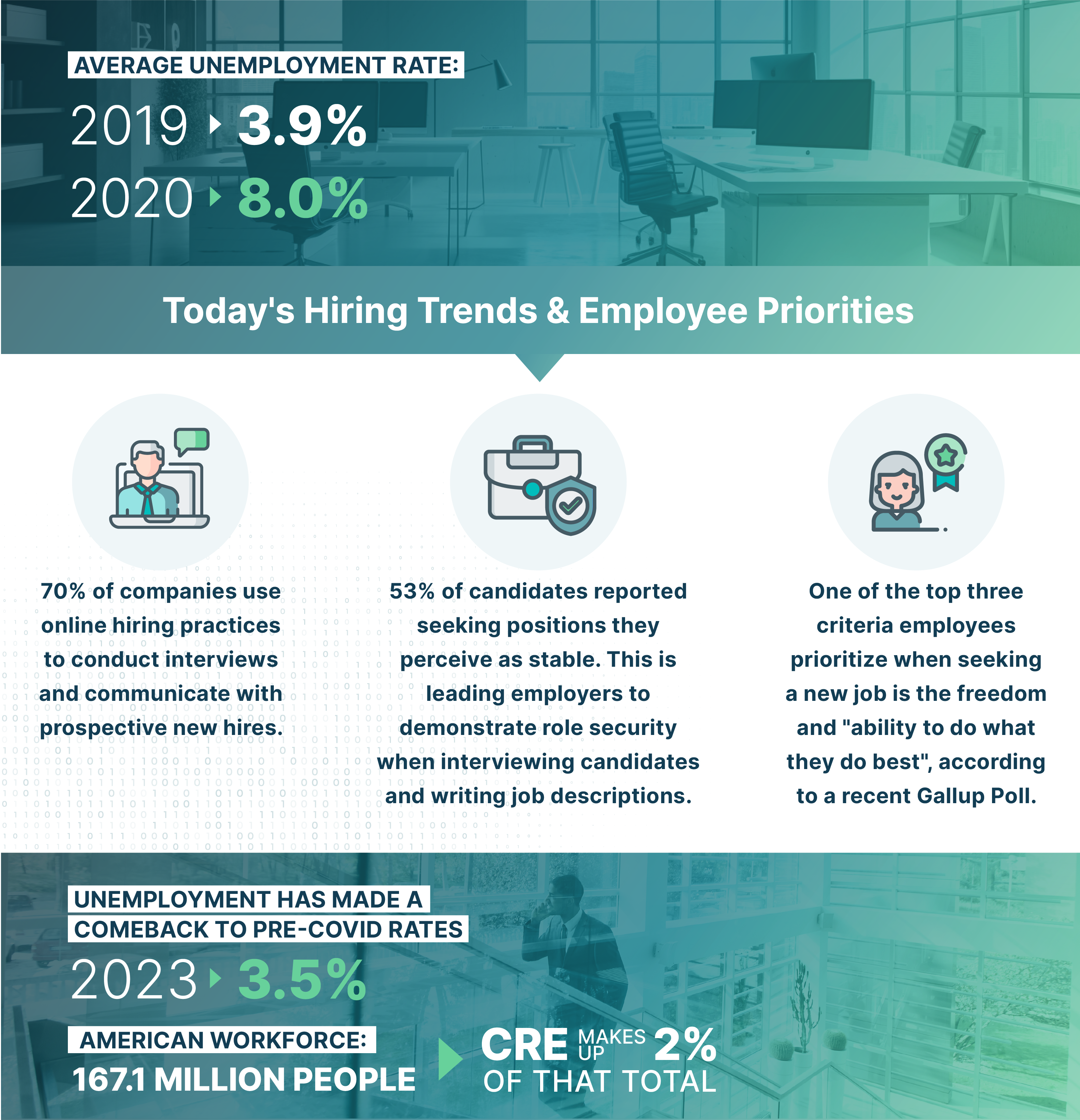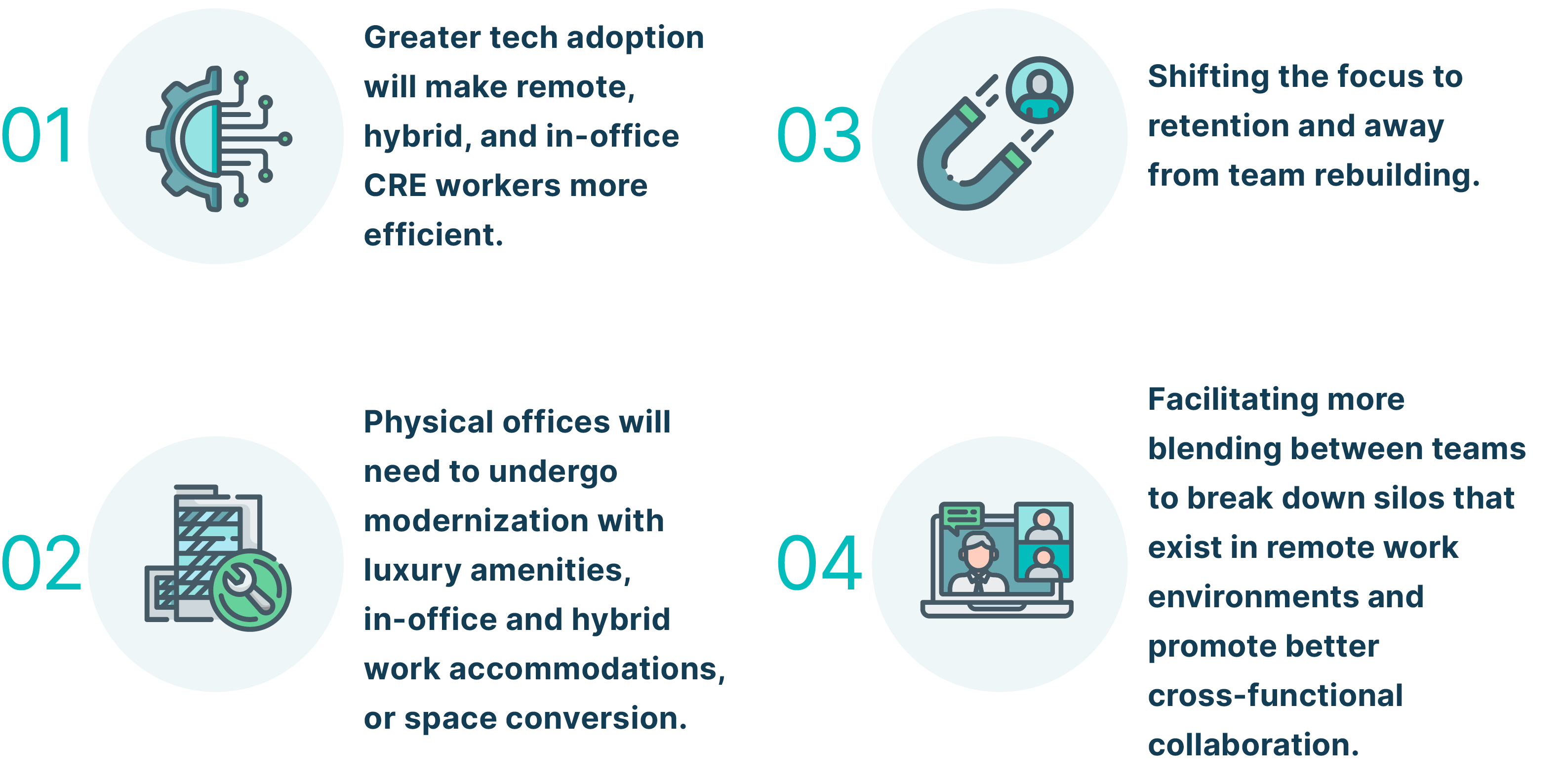Creating the Future CRE Workforce With Flexibility, Experimentation, and Tech
Our platform was built to synthesize your portfolio data, but we also occasionally use it to interpret the trends we're seeing outside of CRE. Check out our exploration into the future state of the CRE workforce.

There are a lot of aspects of commercial real estate that feel up in the air at the present moment. None the least of which are urban office leases, the strained investment landscape, and pressure from emerging AI to innovate.
While some firms tentatively hold on to the crumbling ledge that is unstructured, undigitized portfolio data and a procedural status quo, Prophia is envisioning a highly efficient CRE workforce of the future.
While we normally do this through the lens of data visualization and algorithmic innovation (frankly, rather dry subject matter) rarely do we make predictions about the CRE workforce at-large. That is, until now.
With an ever-growing number of prestigious commercial buildings making their way to the platform by way of client partnerships and expansions, Prophia has been fortunate to build relationships with the individuals who make up the capital-securing and deal-brokering teams of some of the leading CRE firms in the country.
From our frequent conversations with these individuals, and our own observations of workforce trends in the US, the overwhelming take-away is that things are changing. And those changes are not stopping short of the CRE industry.
Jump To A Section in This Article
Today’s Hiring Trends
Shifting Workforce Priorities
What’s on the Horizon for the CRE Workforce?
Today’s Hiring Trends
In April 2020, when the unemployment rate shot up to 14%, this marked a dramatic shift in the United States workforce. While we have managed to settle the unemployment rate down to 3%, hiring and recruiting practices are still shifting to encourage the burned out and disenchanted masses back to work.
Virtual interviews
For one, about 70% of companies hire and recruit largely online. This is a world of difference from 2019 when recruiters were strongly encouraging candidates to have in-person experiences with the prospective new employer. Whether that was participating in a Happy Hour or an in-person event with their new team. And 72% of candidates, at that time, reported a need to understand their new company’s culture before signing an offer.
While these hiring trends speak to the workforce at-large in the United States, commercial real estate is a large hunk of that pie, at about 3 million people or approximately 2%. So it’s safe to assume that the digital hiring practices we all once associated with the fast and loose tech industry are making their way to more conservative corners as employment trends make their waves throughout the entire American workforce.
Demonstrating stability
In a 2022 Gallup workplace poll, researchers found that 53% of candidates are seeking roles that they regard as stable. Whether that stability comes in the form of the importance of their role or the stability of the company, it has remained an important totem for job seekers since about 2015 and doesn’t seem to be going anywhere soon.
For an industry like CRE that is currently facing some insecurity, firms may be struggling to persuade the next generation of brokers, leasing professionals, and asset managers to work with them. Particularly, if firms don’t demonstrate an actionable plan to innovate with the times.
“It’s important for employers to show up as a stabilizing force employees can count on through thick and thin,” Gallup researcher Ben Wigert writes. Benefits and salary continue to be important to candidates, but the particular emphasis on stability tells a crystal clear story of a workforce that has a heightened sensitivity to uncertainty.
Conveying honest expectations
Many candidates in the job market today are prioritizing roles that let them pursue their talents, work that keeps them stimulated and challenged in a compelling way. Candidates are straying more and more from firms and institutions that squander employees’ talents and keep them on the professional bench, so to speak.
This workforce trend is particularly interesting because it sits apart from upward mobility. While career advancement is of course important to many individuals in the American workforce, it did not make the top six things employees are seeking in their next job in the Gallup poll.
Instead, we interpret this finding to mean many employees are looking for employers who accurately and honestly convey the day-to-day requirements of the role and take an honest interest in the aspects of the candidate’s work that excite them. This doesn’t leave any room for companies to hold top-tier talent back with burdensome administrative or repetitive tasks that cause burnout.
The American workforce at-large is still settling into place post pandemic. For those working in CRE, employees of the largest firms are contending with those changes amidst unprecedented market conditions, and that will have an impact on the futures of individuals within the industry.

The way back to pre-pandemic unemployment has been a long road, but industry leaders and hiring professionals have worked hard to pivot their strategies and accommodate the changing needs of the workforce, such as virtual onboarding and hiring, competitive benefits, and more.

Shifting Priorities
Changes to recruiting and hiring practices are a great indicator of the priorities of working individuals. While some of these items remain the same year over year (competitive salary, benefits, etc.), some of the latest workforce trends are more novel. Particularly, for a career-dominated culture like the United States.
Work-life balance leading the charge
According to a 2023 article by Oracle, 60% of applicants show a desire for greater flexibility in their work. When they work, and where they work. This desire has not slowed for individuals working in commercial real estate, in spite of the industry continuing to conduct business at a pace that is much slower than other leading industries.
For many, a work-life balance allows working professionals to keep up on home tasks like running a quick load of laundry during the day or taking care of a sick family member, but it can also lead workers to work longer hours and experience burnout.
Hybrid vs remote work
Figuring out the best work set up is something employers have been struggling with for the past three years. About 16% of employers today operate remotely. In the commercial real estate industry, this number is about 9% and many expect it will continue to increase as younger generations join the workforce and workers continue to prioritize flexibility when they seek new opportunities.
Facilitating hybrid or remote work environments requires companies to be trusting of their employees as well as procedurally agile. It isn’t enough anymore to offer employees a dedicated workstation in an office, companies need to be able to offer work solutions that allow their employees to be productive at the office, at home, or an auxiliary workspace.
Adapting to hybrid or remote work is a smart move for companies today because it all but ensures happier and more productive employees. According to Forbes, 55% of respondents to a remote work productivity survey reported working longer hours than when they worked full-time in-office and 90% reported the same or higher productivity levels than in-office work.
The future of the urban office
We have speculated at-length about what the future holds for the buildings we once called home five days a week before COVID. Today, many of those prime locations sit partially (if not completely) empty, and the firms and financial enterprises controlling the lease aren’t sure what to do with the lack of demand that persists around the assets.
The Prophia data signals a less grievous outcome for these expiring leases than other data providers, like Curbed. The lease schedule ahead looks challenging, to be sure, but not apocalyptic. That is, if the office sector is prepared to rise to the occasion.
The uncertainties of the urban office space represent an important piece of the puzzle that is predicting the future of the American workforce. It is highly possible that the owners of office properties across the country will need to get creative in order to convince companies to mandate full or partial in-office attendance from their workers. This could include spending substantial funds to convert spaces, experimenting with incentives like luxury amenities, or reimagining offices to accommodate hybrid-work models.
Whatever path forward they choose, it will have an impact on employees’ relationship to their jobs and, possibly even, their work.
What’s on the Horizon for Individuals Working in CRE?
With these changes occurring throughout the American workforce, we speculate that the CRE industry will need to adapt in a few ways to meet the changing demands of working professionals while also continuing to build ROI and instill confidence in investors and key stakeholders.
Widespread tech adoption
One of the greatest innovations that will help transform the workforce of the future in CRE and beyond is widespread tech adoption. This means learning to work with technological innovations, like AI, and using those tools to boost the talents of workers, not replace them. AI holds a lot of promise when it comes to the ability to automate administrative tasks, conducting fast research, and even assisting in creative brainstorming.
For professionals in commercial real estate specifically, tech adoption is tricky. For one, CRE data is highly confidential and there’s a lot of it. Some PropTech tools on the market today may be able to process the amount of data found in a major commercial portfolio, but they almost certainly lack the ability to synthesize that data with nuance. Conversely, a tool capable of capturing the nuance may not have the data processing power.
But Prophia has proven time and again that tech adoption is possible in CRE and it can have a serious impact on business decisions. Moreover, firms that streamline administrative processes with tech stand a better chance of attracting and keeping top-tier recruits.
Ditching the status quo
For decades, the CRE industry has conducted critical business tasks manually, from abstracting leases to running rent roll reports. By committing to administrative efficiency, CRE firms can take their business decision-making power into the 21st Century and transform their strategy capabilities, increasing the pace of business. This will give firms a competitive advantage when it comes to generating capital and attracting the next generation of CRE professionals.
Focus on retention
While it is important for CRE firms to attract new talent, the current economic climate is making employee retention more important than ever. Hiring new team members is expensive work and teams with continued high turnover are going to be strategically and, potentially, financially at a disadvantage to firms that make an active move towards investing in their existing workforce.
Removing barriers between teams
The CRE workforce of the future will also be a more blended, synergistic entity than it is today. Property and leasing teams will need to learn to co-mingle effectively with marketing and sales to make more holistic decisions—and CRE executives will need to build work environments that can facilitate that collaboration.
Data silos can be incredibly costly in CRE, and out of sync teams will inevitably miss out on opportunities to affect change. Sharing critical portfolio data not only requires a capable technology solution, it also requires teams to communicate effectively and this will be a critical skill for the future CRE workforce.
CRE and many major industries in the United States are feeling the ground shift beneath their feet and some aren’t sure how to react. With the market down and many workers making their needs known, it’s more important now than ever for companies to invest in time-saving, skill-sharpening tools, and the working conditions their employees need to achieve the goals and ensure client and company success. The future may seem a bit murky to us all now, but it’s apparent that operating under the guise of “business as usual” is no longer a viable business strategy when the professional world is anything but.
Hannah Overhiser
Hannah is Prophia's Content Marketing Manager and a seasoned B2B and B2C marketer. Her career began in eCommerce consulting with a focus on code testing. This technical expertise transferred seamlessly to SEO and she started working agency-side as an SEO and Content Strategist. Today, her home is Prophia, and she puts...

